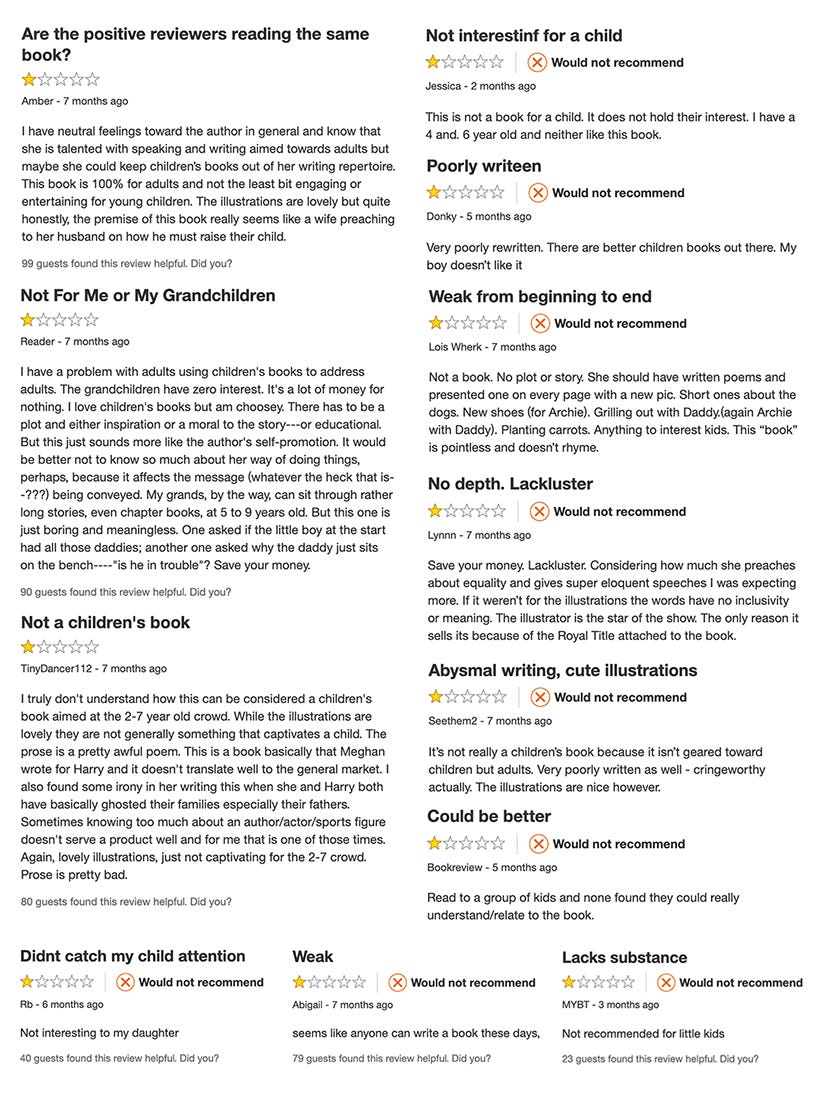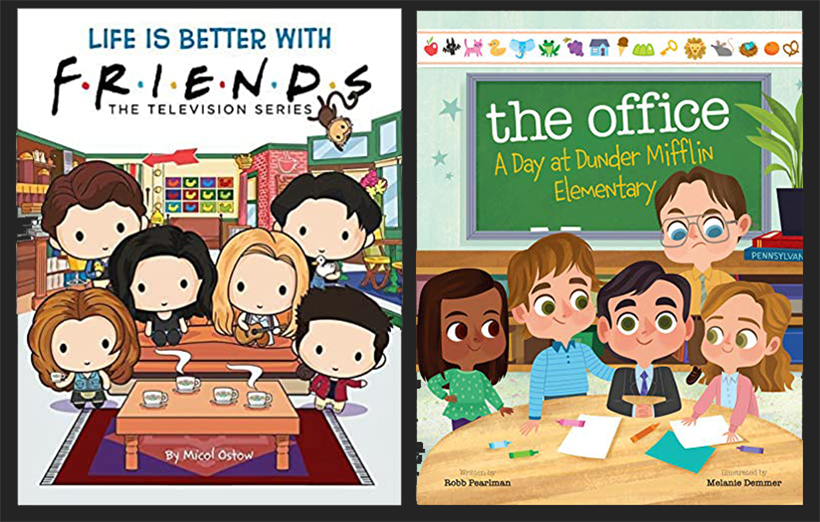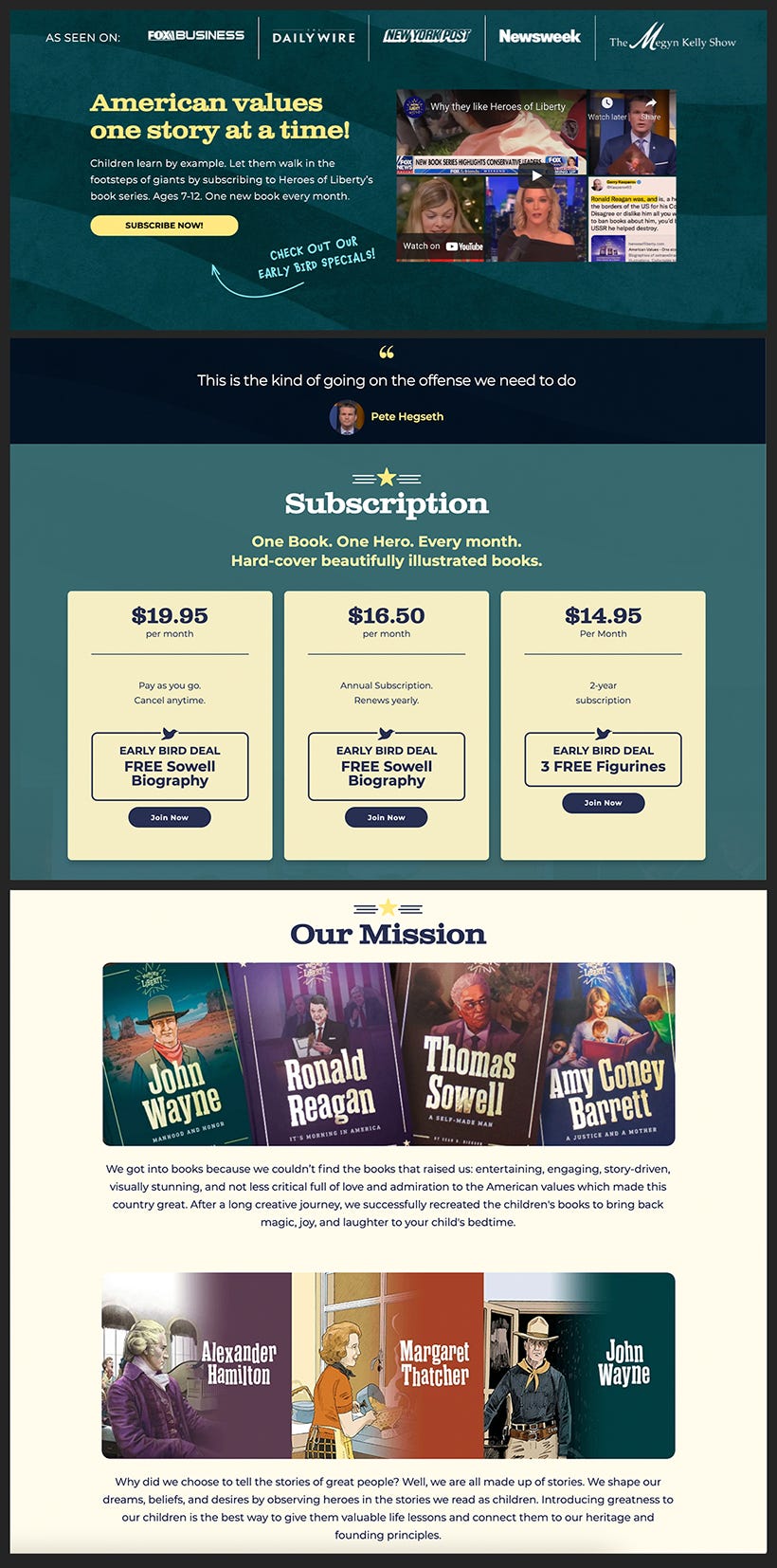Part 1: Superheroes are everywhere
In April 2021, a photo went viral of a children’s cot in an ICE shelter in Long Beach, California. On the cot sat a book by Kamala Harris titled “Superheroes Are Everywhere”. The news story went viral in right-wing media outlets, alleging that Harris’s book was being provided in welcome kits to every child at the shelter. Then it went viral again in liberal media outlets, in the form of a fact-check clap-back: Harris’s book was not in fact provided to every child; it was simply one of a handful of used books donated to the shelter! Take that! Et Voila – The news became about the veracity of the right-wing media sphere, obscuring what propelled this image to virality in the first place – the contradictions laid bare by the image of this book in this context – the cruel absurdity of the place, the author, and the book itself.

Over the past few years, a shift has happened in Children’s books. A whole genre of books has developed – picture books written (or ghostwritten) by or about mostly Democratic Party politicians and other liberal public figures adjacent to power with political careers or lifestyle brands to bolster.

So what are the qualities of these books? What function do they serve? And what can they reveal about the conditions that led to their prevalence? I’ve found that you can group these books into two major stylistic categories, both with similar but slightly different functions.
The Hagiographic Style: Books about Myth-Making
The first is what we might call the Hagiographic Style. This mostly biographical style leans on realism and traditional illustration techniques to valorize individuals as Important Figures in History.
The Norman-Rockwell-esque style of gauzy Americana is used to make heroes out of its subjects, and soften their faults. Conversely, this style is also applied to figures like Martin Luther King Jr. to buff out any economically leftist edges.
This style is the Marble Statue or City Hall Mural of children’s books – the illustrative version of monument building.
The Friendship Style: The Cozy Children’s Cartoon Style with Lessons to Teach
Let’s call this other style, which is far more prevalent and arguably more cynical, the Friendship style. Although also used for biographies & hero making, this style is mainly about communicating Positive Values. This style aims to define moral good (and imply moral wrong) through cartoonish, cozy and cute aesthetics. It provides the real-life figures centered in their stories a halo of unthreatening warmth.
If the Hagiographic style aims for “I am too noble to have done wrong,” this style aims for “I am too cute to do wrong”. How could a smiling cartoon Kamala criminalize parents for the truancy of their children? Why would a respectable young man like cartoon Pete have a resource map of Afghanistan up in his living room?

In their efforts to communicate morals while promoting the author’s personal brand (i.e. ”how to be anti-racist,” “how to be a good friend”, etc) this style makes for painfully bad storytelling.
So who are these books for? The reviews of these books help reveal the answer.
Let’s look at the Target reviews for The Bench, a book by Meghan Markle published in June 2021. (Target’s limited children’s book sections are filled almost exclusively with these sorts of books.)

The reviews are almost entirely polarized; half 5-stars, half 1-star.
The 5-star reviews are vaguely positive – The parents love the “wonderful,” “beautiful” illustrations, and the “good lesson” it teaches their kids. Many cannot even comprehend the negativity towards it.
The 1-star reviews, however, are unanimous and specific in their complaint. Their kids could care less.
So to return to the question, Who are these books for, the answer is clearly not the kids. One might assume politicians may be creating these books to target the pre-voter demographic, so that one day those kids may vote for them or a member of their political dynasty. But if that were their main purpose, you would assume they would create more compelling propaganda. The young readers are an afterthought; their malleability a bonus.
Instead, these books are primarily for the parents (read: voting-age consumers) – to be used as props to signal their values, not only to their kids, but to their friends, either in person or on social media.
After all, these books don’t need to be good, they only need to sell. After moving off store shelves, they sit unloved, collecting dust in children’s libraries and homes.
Which is why within only a year of publication, one of them may wind up donated to a used book drive for an ICE border camp.
The Oligopoly of the Publishing Industry
So how did we get here, where neoliberal children’s books are so prevalent – and where these children’s books are marketed primarily towards the parents rather than the kids?
It’s not a revelation to notice mediocre political children’s books becoming commonplace. Many essays exist about this phenomenon; particularly in conservative spheres (with a few fringe examples that muddy their keep politics-out-of-children’s-books thesis with less savory anxieties over increased diversity in their pages.) However, few essays go beyond that to consider what conditions have led to this political phenomenon.
Just five publishers are able to regularly offer large advances and national marketing reach for books in the U.S.: Penguin/Random House, Hachette Book Group, Harper Collins, Simon and Schuster, and Macmillan.
In November 2021, the Justice Department sued to block Penguin Random House’s attempted acquisition of Simon & Schuster, a merger that would have given PRH more than twice the potential revenue of their nearest competitor.
In the associated press release, the DOJ noted that a board presentation of a Simon & Schuster subsidiary characterized the U.S. publishing industry as an “oligopoly” of Penguin Random House and “only 4 further large publishers.”
Although this was a rare act of antitrust action, it was far too little to make a real difference. The implication of this document is that the current state of things, an openly documented self-described publishing oligopoly, is tolerable, but an outright monopoly would go too far, shattering the illusion of a “Free Market”. In this way, the publishing sector mirrors what has become of U.S. media and technology sectors – the fewest possible number of private entities owning nearly everything, just so as long as an outright monopoly never materializes.
So, in much the same way blockbusters are now mostly sequels and reboots, the risk-adverse publishing giants won’t take chances on no-name authors as readily as they will known quantities – existing intellectual properties and public figures with strong name recognition. This works marvelously for their bottom line, for the powerful authors and brands they work with, and for the liberal parents they sell to – but not for the young readers.
Part 2: The Conservative Children’s Book Alt-Ecosystem
There’s another group this doesn’t work so well for – the Conservatives.
In an earlier time, post-9/11, when George W. Bush was trying to project a “Compassionate Conservatism,” it was more possible for children’s books by conservative political dynasties to get published by one of the large publishers.

However, “Compassionate Conservatism” was never that convincing to begin with, and officially died with the ascendency of Trump. Today, it is very hard to find any children’s books by conservative figureheads published by one of the Big Five publishers.
So, how do these Neocons communicate their values to the future generations? Or rather, how will they, too, talk down to children while bolstering their image in the minds of their constituents?
The answer is by resorting to creating their own alternative presses to get their books published.
Let’s look at some examples.
Heroes of Liberty
It is surprisingly hard to find children’s books about Ronald Reagan – but if you wanted one, Heroes of Liberty has one. Fox News profiled “Heroes of Liberty” in what reads as just short of sponsored content.
And sure enough, on their website, you can immediately see that it has been profiled on the whole suite of right-wing outlets, including the Daily Wire.
The books published by Heroes of Liberty are primarily in the Hagiographic style – after all, like the liberal books, these are books about Heroes. Sometimes the styles employed can be more cartoonish, although the tone is always reverent.

The publisher uses an online subscription model, so that you get automatic deliveries of these books to feed to your kids every month. Subscribe for 2 years and you can get a lil’ Funko Pop of Ronald Reagan. Their branding and marketing has the tone of being on the attack, using the same types of books we’ve identified earlier to stoke anger.
Regnery Books
If it’s hard to find Ronald Reagan Children’s Books, it’s very hard to find any positive children’s books about Donald Trump. And yet, through Regnery Books, you can find something even rarer: an example of The Friendship Style applied to Donald Trump.
Regenry was also the publisher of Mike Pence’s children’s book, Marlon Bundo’s A Day in the Life of The Vice President. It was written by his daughter Charlotte Pence and illustrated by his wife Karen Pence. This book was famously parodied in 2018 by John Oliver on his HBO program Last Week Tonight – but note, that unlike Pence’s, Oliver’s book had no issue being published by an imprint of one of the Big Five publishers, Hachette. Oliver’s book almost explicitly a “children’s book” for adults – but would a kid really care for either of these?
On the Regnery website, you can see they publish more than just children’s books. The selection is a mix of non-fiction opinion books, parenting guides about how to raise Boys as Boys, and Christian books.
Brave Books
Multiple conservative publishers have overt religious connections, including Brave Books.
The group publishes children’s books by U.S. Congressman Dan Crenshaw – including his most recent, an allegory critiquing “cancel culture and the effect it has on society.”
Like Heroes of Liberty, this publisher also offers a subscription service.
The Kid’s Guide to Fighting Socialism
The most bizarre subscription scheme is Mike Huckabee’s Kids Guide to Fighting Socialism. It is a one page website that advertises a gift bundle of a guide, a Highlights-esque children’s magazine called EverBright, and an app.
Conservakids
Most recently, Ben Shapiro promoted the imprint Conservakids via a video with the gimmick that he would teach politics to kids, including terms like “quantitative easing.” Midway though the video, he looks past the kids right into the camera and makes his pitch, framed in the negative:
“There are so many forces out there which are seeking to twist what kids think, there are so many people out there that want your kids to believe things that they really shouldn't believe, who want to take control of your child’s education away from you – not so with Conservakids.”

White Feather Press
And, finally, there are small independent imprints, best exemplified by White Feather Press. The books it has published include My Parents Open Carry by two co-founders of the pro-gun lobby group Michigan Open Carry, Brian Jeffs and Nathan Nephew. It supposedly caused a stir when it was published in 2014.
The finest titles from this publisher, however, all belong to Doug Giles, whose works include If Masculinity is ‘Toxic’ Call Jesus Radioactive, Raising Boys Feminists Will Hate, and Sandy Hook Massacre: When Seconds Count, The Police Are Minutes Away.

Part 3: Get in the Pod, Read the Book
What’s notably different about the books published by these conservative imprints from the previous books we looked at is a sense that these authors care much more about the influence they intend their books to have on the ideology of their young readers. They do not hide their intent to mold young minds; they openly want to make effective propaganda. Additionally, unlike many liberal authors, conservative authors tend to not self-insert themselves into their kids stories – perhaps because their personal brands wouldn’t suit the context.
Many conservative figures do not seek the halo effect that a cozy children’s book would provide their image, because they would rather not be perceived at all.
Yes Every Kid
Take the Koch Brothers for example. The Koch Brothers genuinely want to influence children – but they know that children’s books aren’t the most cost effective way to do that. Lobbying to dismantle the public education system, on the other hand? That’s a start.
In June 2019, the Koch Brothers founded Yes Every Kid, a group that aims to do just that. Its website is vague, and at times strangely threatening. (Are you ready to try learning pods? Yes. Even you.)

The promotional materials all use buzzwords like “innovation,” “revolutionary,” “empowerment,” “success,” and “choice.” It’s not at all clear from the site alone who is behind the effort.
What would it look like for figures like the Koch Brothers, who prefer to act in the shadows, to instead participate in the children’s book personal branding-and-influence industry? To demonstrate the interchangeability of the arbitrary subjects of these books, here is My Brother David, a hypothetical book devoted to the late David Koch, written by his brother Charles, based upon the Joe Biden children’s book biography Joey: The Story of Joe Biden.
Sublimated Outrage at the Adult World
After looking at all these books, it’s worth remembering that children’s books can be more than this. The phenomenon of U.S. political dynasty members penning children’s books is relatively new, but the history of children’s books has always been the tension between the didactic and the subversive – the book that talks down and the book that speaks to.
The books we’ve looked at here have all been fundamentally for adults – for building their brands, for signaling their values, for their ideas to live on, for their comfort, for their security.
The soft and inoffensive visual styles of these books are that way because they appeal not to kids but to young parents’ idea of kids.
The adults who buy these books crave certainty. They want clear divisions between heroes and villains and easy answers, so much so that they believe this is what their kids must also want.
Yet, what children resonate most with is uncertainty, dissonance, and the unexplained – the qualities of growing up. The primary feeling I had when I was younger was a growing sense of the hypocrisy of the adult world. The books I loved most were ones that reflected this reality back to me, and treated the reader with enough respect not to spell everything out.
I am not advocating for “apolitical” children's books – what is apolitical? – but compelling children’s books. In K-Fai Steele’s 2017 essay When Picture Book People Get Political, she quotes Rivka Galchen’s profile of Mo Willems, in which Galchen writes:
Tove Jansson began her Moomin series during the Nazi occupation of Finland; Paddington Bear was modeled on the Jewish refugee children turning up alone in London train stations. Arnold Lobel, the creator of the Frog and Toad books, came out to his children as gay and died relatively young, from AIDS. I wonder if the truer unity among children’s-book authors is sublimated outrage at the adult world. If they’re going to serve someone, it’s going to be children.
It is my conviction that great picture books are often the most inventive and subversive form of media widely available to children. But the conditions that encourage the creation of the sorts of books we’ve explored in this essay must change, or else children’s books will become nothing but adults talking to adults, a vast wasteland.





















This is an excellent, well-crafted analysis. I'm reminded of the "Amazing Amy" children's book artwork that was created for the movie adaptation of Gone Girl. They resemble the "Friendship Style" in the Mayor Pete book (though a little higher quality) and serve the same purpose: warm moral hagiography of a cold, calculating schemer. I got really interested in those materials and didn't know why; they were just offhand promotional materials for a movie. But now I see - there's a distinctive societal trend of selling sociopathy with children's media aesthetics. Good stuff
excellent